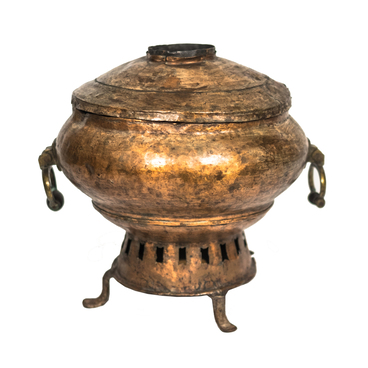This cast-iron mold for baking waffles was produced in the early 20th century by the Kasli plant. Its flaps are heart-shaped with a truncated and widening lower part, with an embossed pattern in the form of leaves and curls. Two handles are riveted to the flaps crosswise, like scissors. One handle ends in a round hole with an oval ring threaded through it, and the other in a cone-shaped knob. There are no marks or writings on the item.
Waffle mold
Creation period
Early 20th century
Dimensions
length: 100.2 cm; flaps: 13.3 cm x 11.5 cm
Technique
Cast iron, casting
Collection
6
Open in app#1
Waffle mold
#11
#20
The tradition of baking waffles was imported into Russia by Germans. Starting in Peter the Great’s era, foreign experts who came to Russia often settled down for a long time. Sugar was an expensive pleasure, and gingerbread would quickly go stale. Traditional German waffles were a salvation for foreigners with a sweet tooth. Then, local residents too became familiar with the foreign innovation. Waffles were prepared using cast iron waffle molds, which soon began to be produced at the Ural plants.
#21
The waffle dough was made from flour, butter, eggs, and honey. The mold was heated in the oven, then the dough was poured into it; then the mold was closed and put back into the oven. The waffles were about 12.5 cm x 8.5 cm in size and a little over 1 cm thick.
#22
In the Russian Empire, waffle molds were manufactured at the Kasli plant. They consisted of two metal handles, joined like scissors, and the baking dish itself, which consisted of two halves. On their inner surface, various ornaments were often applied, which were then imprinted on waffles.
#23
The mold kept in the Nevyansk Architectural and Historical Museum could be bought at a fair or a market. At the Nevyansk plant, fairs were held twice a year, in June and December, and markets were organized every week on Sundays. Not only people from the surrounding villages came here to buy and sell goods, but also residents of other cities of the Urals, Siberia and Central Russia. Successful trade was facilitated by the convenient location of Nevyansk, between Yekaterinburg and the Nizhniy Tagil plant, as well as by the presence of the Siberian Railway and the Ural Mining Railway, which connected Nevyansk with the Urals and Western Siberia.
#24
State Autonomous Cultural Institution of the Sverdlovsk Region "Nevyansk State Historical and Architectural Museum"
read morehide
00:00
00:00
1x
Waffle mold
Creation period
Early 20th century
Dimensions
length: 100.2 cm; flaps: 13.3 cm x 11.5 cm
Technique
Cast iron, casting
Collection
6
Open in app
Share

